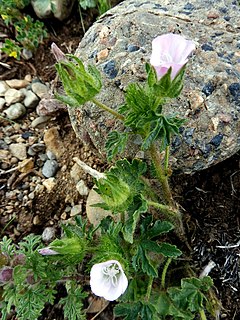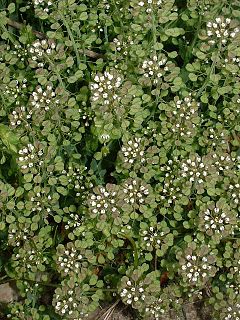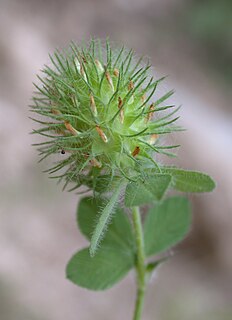
Althaea hirsuta, the hairy marshmallow, is a species of annual herb in the family Malvaceae. They have a self-supporting growth form and simple, broad leaves. Individuals can grow to 28 cm (11 in).
Catapodium rigidum, the ferngrass, is a species of annual grass in the family Poaceae. They have a self-supporting growth form and simple, broad leaves and dry fruit. Individuals can grow to 20 cm tall.
Eleocharis ovata, the ovate spikerush, is a species of annual grass in the family Cyperaceae (sedges). They have a self-supporting growth form and have simple, broad leaves and green flowers. Individuals can grow to 1.5 feet.
Thinopyrum junceum is a species of perennial herb in the family Poaceae. They have a self-supporting growth form and simple, broad leaves. Individuals can grow to 52 cm tall.
Euphorbia melapetala is a plant species in the family Euphorbiaceae.
Euphorbia segetalis, the grainfield spurge, is a species of annual herb in the family Euphorbiaceae. They have a self-supporting growth form and simple, broad leaves. Flowers are visited by Plagiolepis pygmaea, Polistes, and nomad bees. Individuals can grow to 16 cm tall.
Euphorbia terracina, the Geraldton carnation weed, is a species of perennial herb in the family Euphorbiaceae. It has a self-supporting growth form and simple, broad leaves. Flowers are visited by Lipotriches brachysoma, Lipotriches natalensis, Lipotriches crassula, and Nomia bouyssoui.

Frankenia hirsuta is a species of plant in the family Frankeniaceae. They have a self-supporting growth form, individuals can grow to 17 cm tall.
Hypericum australe is a species of plant in the family Hypericaceae. Individuals can grow to 24 cm tall.
Micromeria microphylla is a species of plants in the family Lamiaceae.

Muscari parviflorum is a species of plants in the family Asparagaceae.
Valerianella eriocarpa is a plant species in the family Caprifoliaceae.

Parietaria lusitanica is a species of plant in the family Urticaceae.

Plantago serraria is a species of plants in the family Plantaginaceae.
Romulea variicolor is a species of plant in the family Iridaceae.
Ruppia drepanensis is a species of plant in the family Ruppiaceae.

Thlaspi perfoliatum is a species of plants in the family Brassicaceae.

Trifolium lappaceum, the burdock clover, is a species of annual herb in the family Fabaceae. They have a self-supporting growth form and compound, broad leaves.
Trifolium squarrosum is a species of annual herb in the family Fabaceae. They have a self-supporting growth form and compound, broad leaves.

Trifolium suffocatum, the suffocated clover, is a species of annual herb in the family Fabaceae. They have a self-supporting growth form and compound, broad leaves. Individuals can grow to 4.2 cm.







